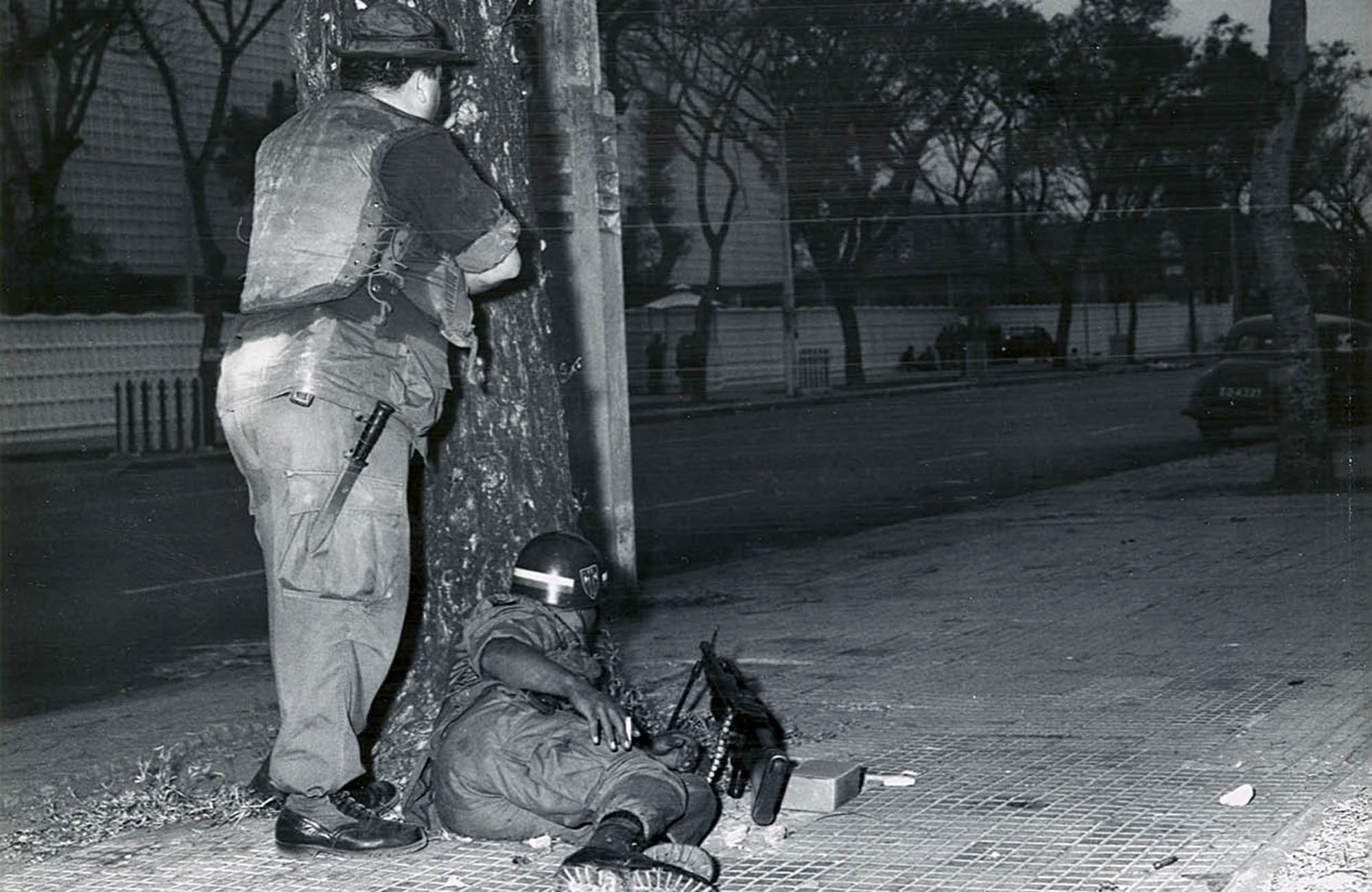

This website was created and maintained from May 2020 to May 2021 to commemorate the 75th anniversary of Stars and Stripes operations in the Pacific.
It will no longer be updated, but we encourage you to explore the site and view content we felt best illustrated Stars and Stripes' continued support of the Pacific theater since 1945.
Saigon embassy attack: ‘They’re coming in!’

In the early hours of Jan. 31, 1968, Viet Cong killed five American servicemembers during an attack on the U.S. Embassy in Saigon.
By Wyatt Olson | Stars and Stripes
HO CHI MINH CITY, Vietnam — In the walled courtyard of the U.S. Consulate in Ho Chi Minh City stands a monument with the names of the five servicemembers who died on the site 50 years ago during an opening salvo of the Tet Offensive. It is the only memorial in the country honoring Americans who died during the long Vietnam War.
In the early hours of Jan. 31, 1968, 19 Viet Cong pulled up in two vehicles beside what was then the U.S. Embassy in Saigon, as the capital of South Vietnam was then called. Construction of the compound’s six-story chancery, which housed the diplomatic mission, had been completed only four months earlier. The new embassy compound had been moved to a more secure site in response to a 1965 car bomb at the original one that killed 20 people and left nearly 200 injured.
At about 3 a.m., the Viet Cong opened fire on the two U.S. Military Police guards — Spc. Charles Daniel and Pvt. 1st Class William Sebast — who were standing watch at the night gate. Daniel radioed his fellow MPs that they were under attack.
Allan Wendt, a 32-year-old Foreign Service officer, was asleep on a cot on the fourth floor of the chancery.
“Suddenly, the building was rocked by a loud explosion,” Wendt wrote of the night in the Foreign Service Journal in 2015. “Automatic weapons fire broke out, and rockets began to thud into the building. The embassy was under attack.”
The Viet Cong raiders blew a hole near the bottom of the compound’s perimeter wall big enough for a man to crawl through. Daniel and Sebast shot two Viet Cong — the assault team’s leaders — as they scrambled through the opening.
Daniel radioed a frantic message, “They’re coming in! They’re coming in!”
Moments later, he and Sebast were shot in the back and killed by two locals employed by the U.S. State Department as embassy drivers who were in fact Viet Cong — guerrilla members of the Vietnamese Communist movement.
Marine Sgt. Ronald Harper, who had been in the rear of the compound, raced to the entry of the embassy’s chancery and sealed the huge teakwood doors.
The Viet Cong fired rocket-propelled grenades at the thick doors, but they withstood the blasts.
Responding to Daniel’s call, MPs Sgt. Johnnie Thomas and Spc. Owen Mebust arrived by jeep at the main gate but were ambushed and killed by a Viet Cong sniper.
Marine Sgt. Rudy Soto Jr. was atop the chancery roof, armed only with a 12-gauge shotgun and a .38-caliber revolver. The U.S. ambassador at the time did not believe the Marine Security Guard needed M-16 rifles. His shotgun jammed, and the small-caliber handgun was next to useless at that range.
The Viet Cong fired rocket-propelled grenades at the chancery walls, penetrating at several points despite construction designed to defend against such an attack.
Marine Cpl. James Marshall climbed to the roof of a small building in the compound and was firing at the Viet Cong until he was wounded by rocket shrapnel. The raiders later shot and killed him, the final American fatality in the embassy siege.
About 5 a.m., a helicopter with troopers from the 101st Airborne Division attempted to land on the chancery’s rooftop helipad, but Viet Cong fire made it impossible.
A different helicopter landed long enough later to medevac a wounded Marine.
“The same chopper also offloaded two cases of M16 tracer ammunition, a move I assumed had some purpose I had not divined: There were no M16s in the building,” Wendt wrote.
The quick deaths of their team leaders left the Viet Cong raiders faltering in their assault. They had with them more than 40 pounds of C4 plastic explosive that could have been used to blow open the teakwood doors, but they never moved to do so.
Instead, the fighters took defensive cover behind a half-dozen large concrete flower planters in the courtyard.
A force of MPs and Marines stormed through the front gate, overwhelming the Viet Cong still left alive. The compound was secured around 9 a.m.
By the end of the gun battle, the corpses of 18 Viet Cong were scattered in the compound, the last man to die lying inside a concrete planter.

A plaque honoring the Americans who died — Marshall, Daniel, Mebust, Sebast and Thomas — was erected in the courtyard later that year.
The U.S. abandoned the embassy — and the plaque — in 1975 as Saigon fell to North Vietnam. Its whereabouts is unknown.
The old chancery and most of the other buildings were razed in the mid-1990s to make way for the U.S. Consulate after the two countries resumed diplomatic relations.
A replica of the plaque was subsequently dedicated. It stands beside one of the few original features left in the compound from the 1968 firefight: the planter ring where the last enemy guerrilla died.


